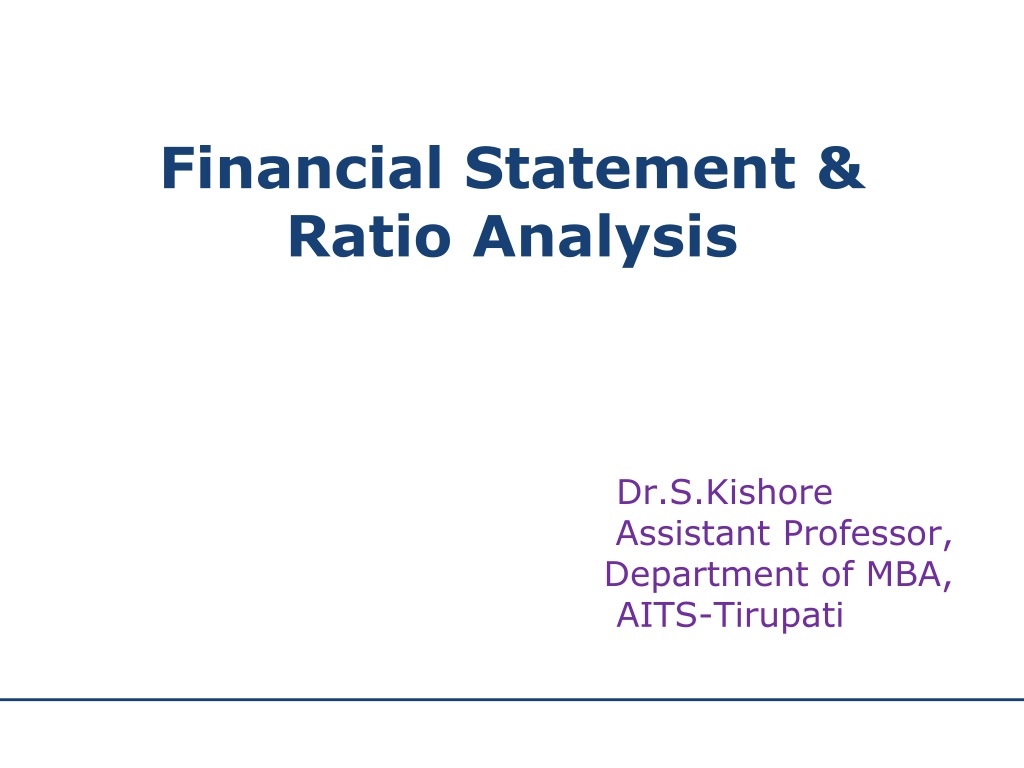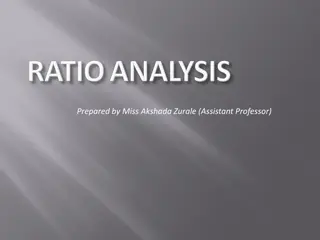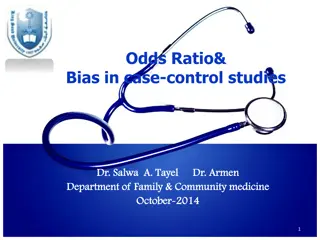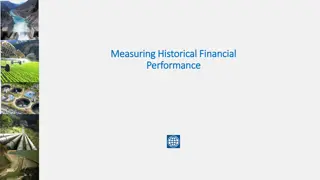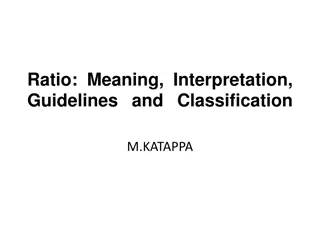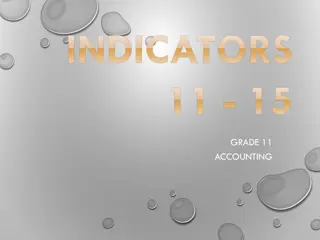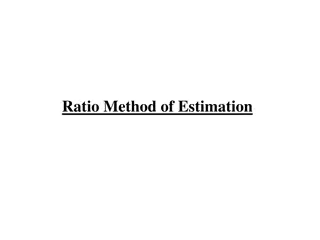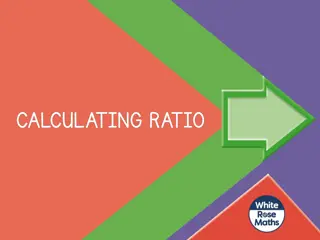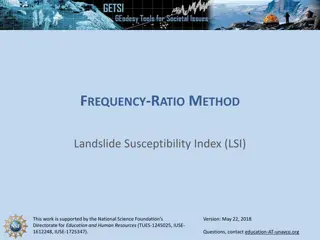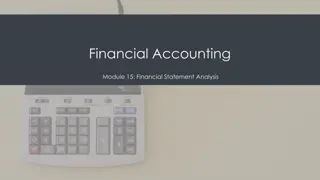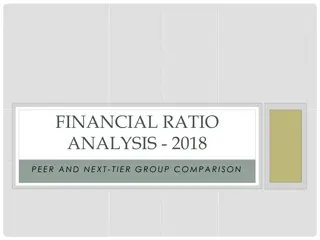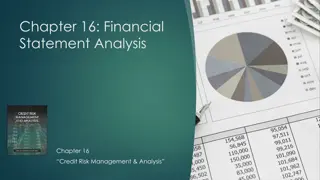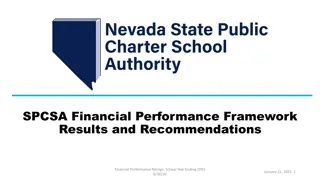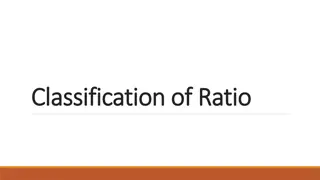Understanding Financial Statement and Ratio Analysis
This informative content discusses the importance of financial statement and ratio analysis in assessing a firm's past, present, and future financial conditions. It covers the primary tools used, such as financial statements and comparison of financial ratios, as well as the objectives of ratio analysis. The content also delves into different aspects of ratio analysis including liquidity, profitability, and financial efficiency, providing insights into evaluating a company's financial strength and weaknesses.
Download Presentation

Please find below an Image/Link to download the presentation.
The content on the website is provided AS IS for your information and personal use only. It may not be sold, licensed, or shared on other websites without obtaining consent from the author. Download presentation by click this link. If you encounter any issues during the download, it is possible that the publisher has removed the file from their server.
E N D
Presentation Transcript
Financial Statement & Ratio Analysis Dr.S.Kishore Assistant Professor, Department of MBA, AITS-Tirupati
Financial Analysis Assessment of the firm s past, present and future financial conditions Done to find firm s financial strengths and weaknesses Primary Tools: Financial Statements Comparison of financial ratios to past, industry, sector and all firms
Financial Statements Balance Sheet Income Statement Cashflow Statement Statement of Retained Earnings
Objectives of Ratio Analysis Standardize financial information for comparisons Evaluate current operations Compare performance with past performance Compare performance against other firms or industry standards Study the efficiency of operations Study the risk of operations
Ratio Analysis 1. 2. Liquidity the ability of the firm to pay its way Investment/shareholders information to enable decisions to be made on the extent of the risk and the earning potential of a business investment Profitability how effective the firm is at generating profits given sales and or its capital assets Financial the rate at which the company sells its stock and the efficiency with which it uses its assets 3. 4.
Acid Test Also referred to as the Quick ratio (Current assets stock) : liabilities 1:1 seen as ideal The omission of stock gives an indication of the cash the firm has in relation to its liabilities (what it owes) A ratio of 3:1 therefore would suggest the firm has 3 times as much cash as it owes very healthy! A ratio of 0.5:1 would suggest the firm has twice as many liabilities as it has cash to pay for those liabilities. This might put the firm under pressure but is not in itself the end of the world!
Current Ratio Looks at the ratio between Current Assets and Current Liabilities Current Ratio = Current Assets : Current Liabilities Ideal level? 1.5 : 1 A ratio of 5 : 1 would imply the firm has 5 of assets to cover every 1 in liabilities A ratio of 0.75 : 1 would suggest the firm has only 75p in assets available to cover every 1 it owes Too high Might suggest that too much of its assets are tied up in unproductive activities too much stock, for example? Too low - risk of not being able to pay your way
Investment/Shareholders Earnings per share profit after tax / number of shares Price earnings ratio market price / earnings per share the higher the better generally for company. Comparison with other firms helps to identify value placed on the market of the business. EV / EBITDA Ratio - Enterprise Value / EBITDA ratio - the higher the better generally for company . It measures the operational performance of the firm. Dividend yield ordinary share dividend / market price x 100 higher the better. Relates the return on the investment to the share price.
Profitability Profitability measures look at how much profit the firm generates from sales or from its capital assets Different measures of profit gross and net Gross profit effectively total revenue (turnover) variable costs (cost of sales) Net Profit effectively total revenue (turnover) variable costs and fixed costs (overheads)
Profitability Gross Profit Margin = Gross profit / turnover x 100 The higher the better Enables the firm to assess the impact of its sales and how much it cost to generate (produce) those sales A gross profit margin of 45% means that for every 1 of sales, the firm makes 45p in gross profit
Profitability Net Profit Margin = Net Profit / Turnover x 100 Net profit takes into account the fixed costs involved in production the overheads Keeping control over fixed costs is important could be easy to overlook for example the amount of waste - paper, stationery, lighting, heating, water, etc. e.g. leaving a photocopier on overnight uses enough electricity to make 5,300 A4 copies. (1,934,500 per year) 1 ream = 500 copies. 1 ream = 5.00 (on average) Total cost therefore= 19,345 per year or 1 person s salary
Profitability Return on Capital Employed (ROCE) = Profit / capital employed x 100
Profitability The higher the better Shows how effective the firm is in using its capital to generate profit A ROCE of 25% means that it uses every 1 of capital to generate 25p in profit Partly a measure of efficiency in organisation and use of capital
Asset Turnover Asset Turnover = Sales turnover / assets employed Using assets to generate profit Asset turnover x net profit margin = ROCE
Stock Turnover Stock turnover = Cost of goods sold / stock expressed as times per year The rate at which a company s stock is turned over A high stock turnover might mean increased efficiency? But: dependent on the type of business supermarkets might have high stock turnover ratios whereas a shop selling high value musical instruments might have low stock turnover ratio Low stock turnover could mean poor customer satisfaction if people are not buying the goods (Marks and Spencer?)
Debtor Days Debtor Days = Debtors / sales turnover x 365 Shorter the better Gives a measure of how long it takes the business to recover debts Can be skewed by the degree of credit facility a firm offers
Before looking at the ratios there are a number of cautionary points concerning their use that need to be identified : a. The dates and duration of the financial statements being compared should be the same. If not, the effects of seasonality may cause erroneous conclusions to be drawn. b. The accounts to be compared should have been prepared on the same bases. Different treatment of stocks or depreciations or asset valuations will distort the results. c. In order to judge the overall performance of the firm a group of ratios, as opposed to just one or two should be used. In order to identify trends at least three years of ratios are normally required.
SOME IMPORTANT NOTES Liabilities have Credit balance and Assets have Debit balance Current Liabilities are those which have either become due for payment or shall fall due for payment within 12 months from the date of Balance Sheet Current Assets are those which undergo change in their shape/form within 12 months. These are also called Working Capital or Gross Working Capital Net Worth & Long Term Liabilities are also called Long Term Sources of Funds Current Liabilities are known as Short Term Sources of Funds Long Term Liabilities & Short Term Liabilities are also called Outside Liabilities Current Assets are Short Term Use of Funds
SOME IMPORTANT NOTES Assets other than Current Assets are Long Term Use of Funds Installments of Term Loan Payable in 12 months are to be taken as Current Liability only for Calculation of Current Ratio & Quick Ratio. If there is profit it shall become part of Net Worth under the head Reserves and if there is loss it will become part of Intangible Assets Investments in Govt. Securities to be treated current only if these are marketable and due. Investments in other securities are to be treated Current if they are quoted. Investments in allied/associate/sister units or firms to be treated as Non- current. Bonus Shares as issued by capitalization of General reserves and as such do not affect the Net Worth. With Rights Issue, change takes place in Net Worth and Current Ratio.
EXERCISE 1 LIABILITES Capital Reserves Term Loan ASSETS 180 Net Fixed Assets 20 Inventories 300 Cash 200 Receivables 50 Goodwill 50 800 400 150 50 150 50 Bank C/C Trade Creditors Provisions 800 a. What is the Net Worth : Capital + Reserve = 200 b. Tangible Net Worth is : Net Worth - Goodwill = 150 c. Outside Liabilities : TL + CC + Creditors + Provisions = 600 d. e. f. Net Working Capital : C A - C L = 350 - 250 = 50 Current Ratio : C A / C L = 350 / 300 = 1.17 : 1 Quick Ratio : Quick Assets / C L = 200/300 = 0.66 : 1
EXERCISE 2 LIABILITIES 2005-06 2006-07 ASSETS 2005- 06 2006- 07 Capital 300 350 Net Fixed Assets 730 750 Reserves 140 160 Security Electricity Investments Raw Materials S I P 30 30 Bank Term Loan Bank CC (Hyp) Unsec. Long T L 320 490 150 280 580 170 110 150 20 110 170 30 Creditors (RM) 120 70 Finished Goods 140 170 Bills Payable Expenses Payable 40 20 80 30 Cash Receivables 30 20 310 240 Provisions 20 40 Loans/Advances 30 190 Goodwill 50 50 Total 1600 1760 1600 1760 1. Tangible Net Worth for 1st Year : ( 300 + 140) - 50 = 390 2. Current Ratio for 2nd Year : (170 + 30 +170+20+ 240 + 190 ) / (580+70+80+70) 820 /800 = 1.02 3. Debt Equity Ratio for 1st Year : 320+150 / 390 = 1.21
Exercise 3. LIABIITIES Equity Capital Preference Capital Term Loan Bank CC (Hyp) ASSETS 200 Net Fixed Assets 100 Inventory 600 Receivables 400 Investment In Govt. Secu. 100 Preliminary Expenses 1400 800 300 150 50 Sundry Creditors Total 100 1400 1. Debt Equity Ratio will be : 600 / (200+100) = 2 : 1 2. Tangible Net Worth : Only equity Capital i.e. = 200 3. Total Outside Liabilities / Total Tangible Net Worth : (600+400+100) / 200 = 11 : 2 4. Current Ratio will be : (300 + 150 + 50 ) / (400 + 100 ) = 1 : 1
Exercise 4. LIABILITIES Capital + Reserves P & L Credit Balance Loan From S F C Bank Overdraft Creditors Provision of Tax Proposed Dividend ASSETS Net Fixed Assets 7 Cash 100 Receivables 38 Stocks 26 Prepaid Expenses 9 Intangible Assets 15 550 355 265 1 125 128 1 30 550 Q. What is the Current Ratio ? Ans : (1+125 +128+1) / (38+26+9+15) : 255/88 = 2.89 : 1 Q What is the Quick Ratio ? Ans : (125+1)/ 88 = 1.43 : 11 Q. What is the Debt Equity Ratio ? Ans : LTL / Tangible NW = 100 / ( 362 30) = 100 / 332 = 0.30 : 1
Exercise 4. contd LIABILITIES Capital + Reserves P & L Credit Balance Loan From S F C Bank Overdraft Creditors Provision of Tax Proposed Dividend ASSETS Net Fixed Assets 7 Cash 100 Receivables 38 Stocks 26 Prepaid Expenses 9 Intangible Assets 15 550 355 265 1 125 128 1 30 550 Q. What is the Debtors Velocity Ratio ? If the sales are Rs. 15 Lac. Ans : ( Average Debtors / Net Sales) x 12 = (125 / 1500) x 12 = 1 month Q. What is the Creditors Velocity Ratio if Purchases are Rs.10.5 Lac ? Ans : (Average Creditors / Purchases ) x 12 = (26 / 1050) x 12 = 0.3 months
Exercise 5. : Profit to sales is 2% and amount of profit is say Rs.5 Lac. Then What is the amount of Sales ? Answer : Net Profit Ratio = (Net Profit / Sales ) x 100 2 = (5 x100) /Sales Therefore Sales = 500/2 = Rs.250 Lac Exercise 6. A Company has Net Worth of Rs.5 Lac, Term Liabilities of Rs.10 Lac. Fixed Assets worth RS.16 Lac and Current Assets are Rs.25 Lac. There is no intangible Assets or other Non Current Assets. Calculate its Net Working Capital. Answer Total Assets = 16 + 25 = Rs. 41 Lac Total Liabilities = NW + LTL + CL = 5 + 10+ CL = 41 Lac Current Liabilities = 41 15 = 26 Lac Therefore Net Working Capital = C. A C.L = 25 26 = (- )1 Lac
Exercise 7 : Current Ratio of a concern is 1 : 1. What will be the Net Working Capital ? Answer : It suggest that the Current Assets is equal to Current Liabilities hence the NWC would be NIL ( since NWC = C.A - C.L ) Exercise 8 : Suppose Current Ratio is 4 : 1. NWC is Rs.30,000/-. What is the amount of Current Assets ? Answer : 4a - 1a = 30,000 Therefore a = 10,000 i.e. Current Liabilities is Rs.10,000 Hence Current Assets would be 4a = 4 x 10,000 = Rs.40,000/- Exercise 9. The amount of Term Loan installment is Rs.10000/ per month, monthly average interest on TL is Rs.5000/-. If the amount of Depreciation is Rs.30,000/- p.a. and PAT is Rs.2,70,000/-. What would be the DSCR ? DSCR = (PAT + Depr + Annual Intt.) / Annual Intt + Annual Installment = (270000 + 30000 + 60000 ) / 60000 + 120000 = 360000 / 180000 = 2
Exercise 10 : Total Liabilities of a firm is Rs.100 Lac and Current Ratio is 1.5 : 1. If Fixed Assets and Other Non Current Assets are to the tune of Rs. 70 Lac and Debt Equity Ratio being 3 : 1. What would be the Long Term Liabilities? Ans : We can easily arrive at the amount of Current Asset being Rs. 30 Lac i.e. ( Rs. 100 L - Rs. 70 L ). If the Current Ratio is 1.5 : 1, then Current Liabilities works out to be Rs. 20 Lac. That means the aggregate of Net Worth and Long Term Liabilities would be Rs. 80 Lacs. If the Debt Equity Ratio is 3 : 1 then Debt works out to be Rs. 60 Lacs and equity Rs. 20 Lacs. Therefore the Long Term Liabilities would be Rs.60 Lac. Exercise 11 : Current Ratio is say 1.2 : 1 . Total of balance sheet being Rs.22 Lac. The amount of Fixed Assets + Non Current Assets is Rs. 10 Lac. What would be the Current Liabilities? Ans : When Total Assets is Rs.22 Lac then Current Assets would be 22 10 i.e Rs. 12 Lac. Thus we can easily arrive at the Current Liabilities figure which should be Rs. 10 Lac
Exercise 12. From the following financial statement calculate (i) Current Ratio (ii) Acid test Ratio (iii) Inventory Turnover (iv) Average Debt Collection Period (v) Average Creditors payment period. C.Assets Sales 1500 Cost of sales 1000 Debtors 250 Gross profit 500 Cash 225 C. Liabilities 200 Inventories 125 Trade Creditors (i) Current Ratio : 600/200 = 3 : 1 (ii)Acid Test Ratio : Debtors+Cash /Trade creditors = 475/200 = 2.4 : 1 (iii) Inventory Turnover Ratio : Cost of sales / Inventories = 1000/125 = 8 times (iv) Average Debt collection period : (Debtors/sales) x 365 = (250/1500)x365 = 61 days (v)Average Creditors payment period : (Trade Creditors/Cost of sales) x 365 (200/100) x 365 = 73 days
Summary of Financial Ratios Ratios help to: Evaluate performance Structure analysis Show the connection between activities and performance Benchmark with Past for the company Industry Ratios adjust for size differences
Limitations of Ratio Analysis A firm s industry category is often difficult to identify Published industry averages are only guidelines Accounting practices differ across firms Sometimes difficult to interpret deviations in ratios Industry ratios may not be desirable targets Seasonality affects ratios
